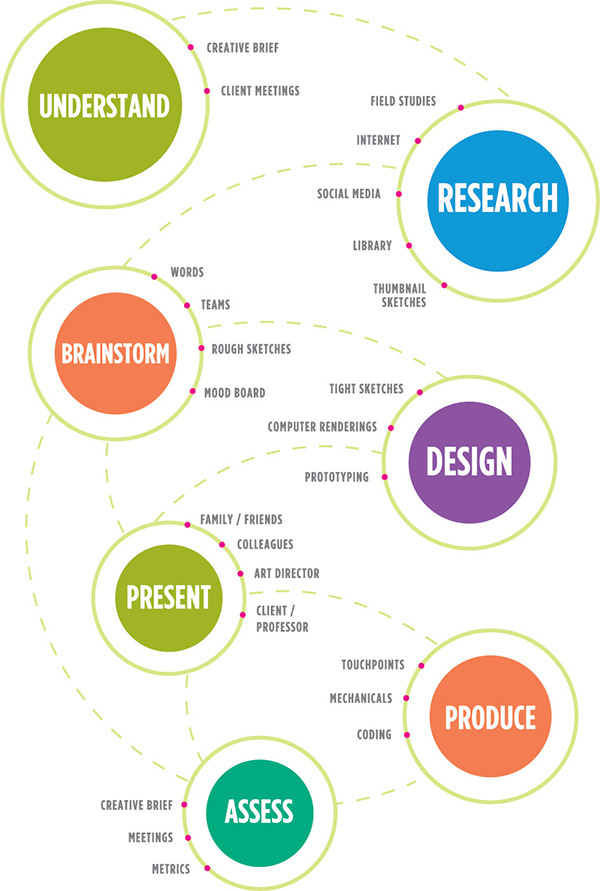8. Create New Projects
Adding work to complete your book.
On a recent school break, my son Dylan decided it was time to ride his bike without training wheels. He was eager to reach his goal and passionate in his pursuit of success, but it took a few tries and a few failures. On several occasions, he had to be rescued—we pulled him out of a hedge where he had landed face-first, nursed some bumps after he bounced off a rock, and bandaged a cut that resulted from his knocking a landscape light out of the ground. Sure, there were tears, first-aid spray, and even a little blood, but we encouraged him and he persevered. By the end of the week, he was riding his two-wheeler like a pro. Like Dylan, most of us master riding a bicycle at some point, and the real lesson we learned probably isn’t “slow into the turns” but rather “practice makes you better.”
I worked as a graphic designer for seven years before I felt like a professional. And when I “arrived,” it happened suddenly, when I was assigned a project. I don’t remember much about the design details—a brand identity and collateral materials for an event on behalf of a large telecom company. The colors were purple and copper metallic, printed on textured paper with illustrations of lightning bolts—but its significance was almost blinding. It was the first time I was given responsibility for every aspect of a program, from holding client meetings and concept development to design, production, and printing. By the end of the project, I felt incredibly accomplished because it met the client’s needs, it was aesthetically pleasing, and my art director was delighted with the outcome. But that accomplishment didn’t spring from some untapped well of superhero powers; it was the result of the seven years I had already put in, my determination to learn as much as I could about the design business, and my willingness to take on the next learning experience. Just as runners train for a marathon, chefs study recipes to prepare for cooking contests, and musicians run scales for years before they perform in front of an audience, designers need to exercise their visual and verbal problem-solving skills. The more you practice, the better you’ll be.
Stand Out is not about teaching you how to create projects—there are endless resources for that online and at your local bookstore. But it’s important that you see (and perhaps become inspired by) how others have approached this challenge by reviewing the projects and portfolios that they worked hard to build.
Criteria for Creating Practice Projects
The projects you create in school and those you make up on your own (your passion projects) are dress rehearsals for the professional design world. When I create assignments for my students, I make it a point to replicate the types of projects and processes that are generally required in professional practice. As an educator, I allow room for a broad range of interpretation and encourage students to customize themes according to their interests, skills, and the industry where they want to work.
My objective is simple: identify and assign practice projects that call upon a variety of skills, develop a designer’s abilities, and teach different design-thinking strategies. Whether you are a student building your own portfolio or an instructor in search of projects to assign, these activities will guide you to finding and creating projects that will give breadth and depth to a book of work, in addition to providing the experience and skills that a professional practitioner needs.
Create projects with a focus on different industries (e.g., entertainment, retail, not-for-profit, and start-ups) to enhance exposure to a variety of fields. One may spur an interest or ignite a passion.
Create different project types (e.g., rebranding, branding, advertising, and promotion) as an introduction to the variety of strategic problem-solving approaches to design problems and to diversify the portfolio.
Solicit not-for-profit projects to gain professional design experience and assist an organization with its mission. Each semester, I ask my branding students to contribute to a pro bono project; it’s not only great for the students but keeps my feet wet and in the game.
Offer multiple options for each project to avoid a potential employer pegging anyone by the college they attend because they see the same project every year. (Not every student is motivated by every project, so if the project you’re assigning is, for example, a rebranding program for a local business, you can offer an alternative option or ask students to come up with a rebranding project of their own.)
Use or improve an already completed project from an internship, freelance gig, or job. Practicing with real professional projects is great, but they should be good enough to appear in a portfolio. Students should always ask permission from the client or an employer to use their project in their personal book of work.
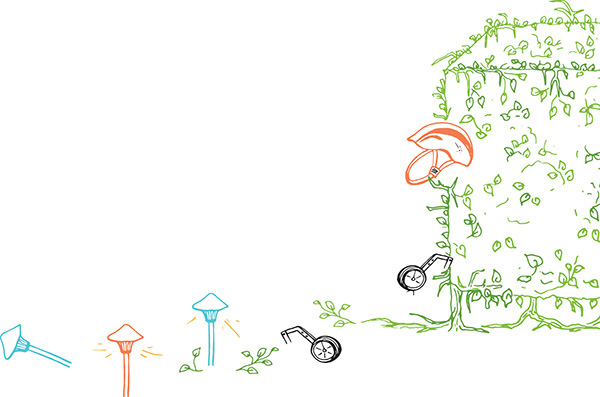
The Creative Brief (For Projects)
A creative brief is a one-page document that summarizes the strategic objectives and needs of a project for the creative team. In Chapter 2, you used a creative brief to define your personal brand, outline your purpose, target your audience, make your brand statement, offer your unique selling proposition, and provide a range of relevant facts about who you are. In this chapter, the creative brief has been modified to use for developing your portfolio projects. Simply complete the form with your project in mind rather than your personal brand.
Just as you have to do the work in order to reap the rewards of your true and authentic personal brand identity, you have to follow a process to get the most benefit from designing meaningful projects. Creating or using a supplied creative brief is absolutely necessary if you want your project to have a strong foundation and a clear purpose. Your work might be beautiful, but an art director wants to see design thinking, problem solving, and the ability to understand and fulfill a set of requirements. (Revisit Chapters 1 through 3 to brush up on how to capture the background information.) In the professional world, the creative brief sums up the project details you’ll need to meet the client’s needs, expectations, and requirements.
Project Objectives
Describes why the project was initiated and its purpose. List up to five objectives and anticipated outcomes that will be used to determine whether the project is successful.
Target Audience
The characteristics of your intended market. List key points about the demographics (i.e., gender, age, ethnicity, economic status) and psychographics (i.e., attitudes, taste, emotions) of the project’s target audience.
Project Deliverables/Brand Touchpoints
How the brand identity will be delivered to the audience and how selected touchpoints will visually communicate the brand story. Select appropriate touchpoints across multiple channels (print and screen) that emotionally connect your brand to the audience.
Audience Needs
How the project design fulfills the needs and expectations of the audience. List up to five needs your audience may have, and describe how you will meet those needs through the components of your design and how you expect your audience to respond.
Brand Statement
A clear and concise articulation of your story idea. Write a short paragraph describing the idea behind your brand story. Make sure your story includes rich and believable content that illustrates what makes your brand unique.
Value Proposition
The unique, positive attributes, passions, and strengths that you can deliver to help the project meet its objectives. Write three short sentences describing what you can offer the target audience (that no one else can).
Brand Promise
The single most compelling value you can deliver to the project on behalf of your client. Your brand promise sums up what sets you apart. In six words or less, describe with passion and power one value that your product, service, or brand will live up to every day—the promise your target audience can rely on.
Brand Characteristics
Attributes that communicate the character of the brand. List up to six words that describe the personality and style of the project brand, and connect it to the target audience.

The objective of this assignment was to design a brand identity for an exclusive “men’s only” barbershop. I asked my students to develop projects that communicated the style of work that they wanted to be known for. Even with the same project objective, each student added a twist that showcased his or her skills, experience, and interests. Jon produced a gentleman’s barbershop for the Zen crowd that communicated the type of business he wanted to frequent. Sean, who loves graphic novels, designed a Japanese barber and sticker shop. Inspired by his grandfather, Dave created the experience of a 1920s speakeasy social club. Before actual designing took place, each student had to develop a brand concept based on the project objectives I provided. The creative brief for Dave’s “Tomaselli’s Barbershop and Social Club” is included on the previous page.

JON MUI: jonmui.com
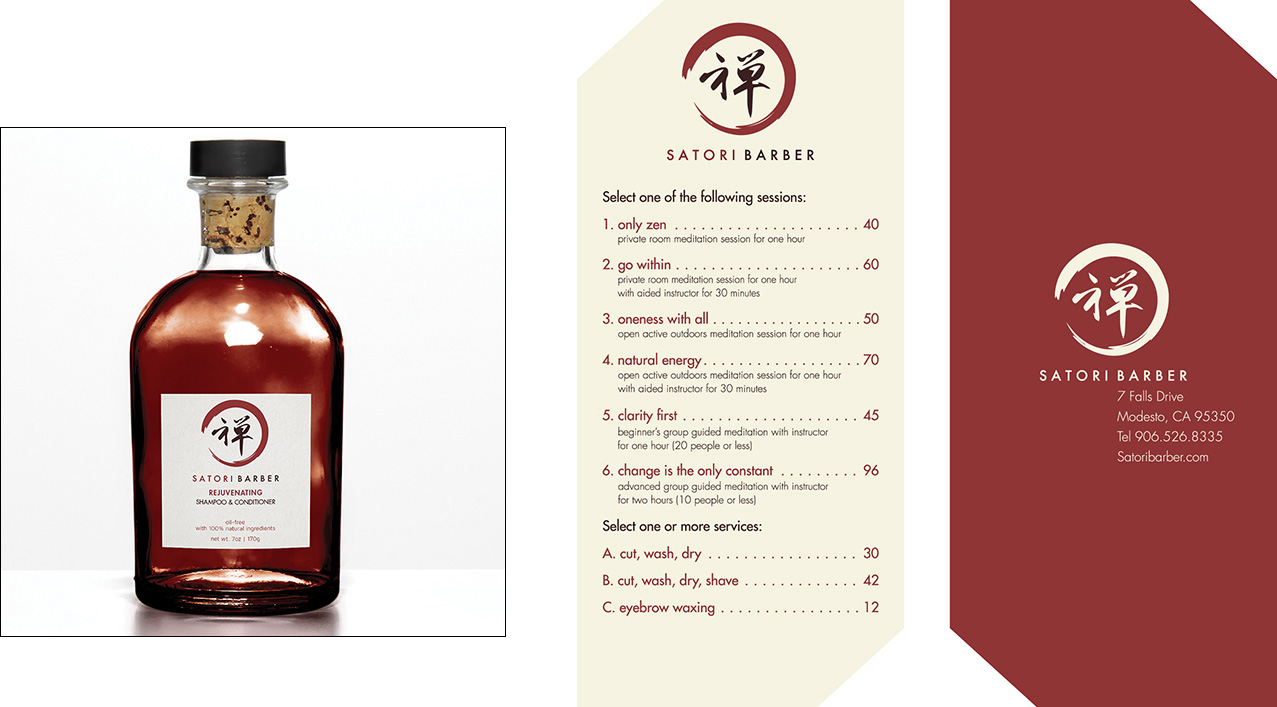
HSIEN-WEN “SEAN” SHU: hcdesignsean.com
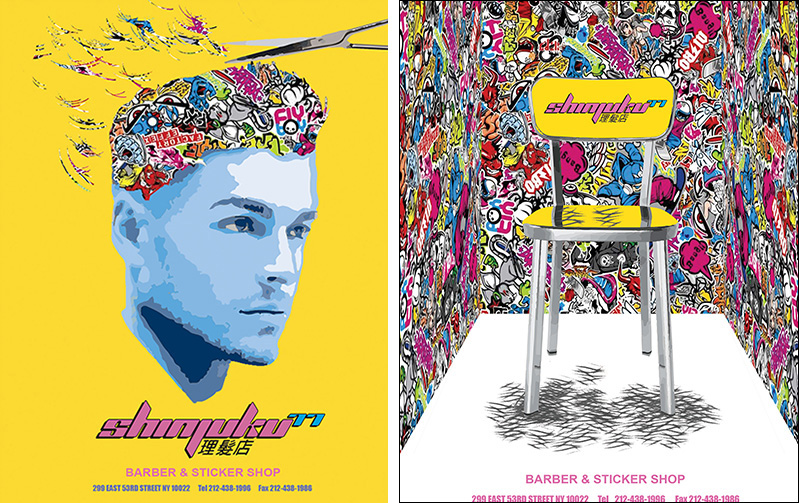
JEFFERSON SALDANA: jeffersonsaldana.com

ALEXA MATOS: alexadesign.co

CARLOS HERNANDEZ: hcdesignsean.com

The Creative Process (Revisited)
When you initiate a design, you tend to follow a set of steps, and odds are you will repeat many of those actions with every project: that’s the foundation of your creative process. This is not an inflexible regimen; you should be able to tailor your approach to considerations such as purpose, medium, and style. Your creative process should be elastic and adaptable enough to provide a structure you can fall back on when you are challenged or stumped. Few designers achieve their goals without following a consistent process.
You’ve learned about the creative process as you’ve progressed through design school, so you probably have a good understanding of what it takes to execute. Unfortunately, technology and competing priorities make it very tempting to take shortcuts. Be advised: choosing the easy path is rarely the wisest route in the long run. Never let someone hand you a “canned” solution. (There’s no app for that!) You are responsible for initiating, developing, designing, and producing the brilliant ideas in your portfolio just as you will be responsible for initiating, developing, designing, and producing the brilliant ideas in your workplace.
Creative processes can vary from designer to designer. Some work through the night, while others add coffee breaks and power naps to their schedule. A process will evolve that works best for you. In the meantime, this diagram contains the standard main phases of a creative process that you can follow. Feel free to create your own and hang it in your workspace so you won’t forget any of the components, and to remind yourself of the design steps that are most effective for your process.
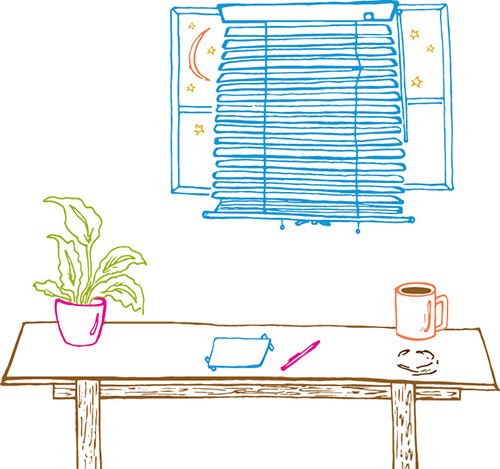
• Review the creative brief carefully to understand the expectations for the project. Make notations where you need clarification.
• Meet with your client (or professor), ask questions, and hear his or her answers.
• Set expectations about deliverables and scheduling.
• Inform and educate the client (or professor) about your progress.
Research
Analyze and form conclusions.
• Identify the demographic and psychographic attributes of your intended audience.
• Go to where your target audience does business and observe their behaviors.
• Do field studies to understand the problem you need to solve.
• Gain insights by understanding the client’s business goals, mission, vision, values, brand equity, and what others think about the brand.
• Research competing brands, evaluate their similarities and differences, and identify one or two things that will make yours stand out.
• Sketch small thumbnail drawings based on free association of ideas.
Brainstorm
Identify ideas and meaningful solutions.
• Create a word list that encapsulates the passion and personality of the brand.
• Sketch a mind map (a diagram that organizes information visually) and look for connections between your ideas.
• Assemble a team of people and listen for different views and opinions.
• Develop a storyboard and organize ideas into a refined visual sequence.
• Do something else. The best ideas often come when your focus is elsewhere.
• Build a mood board via Pinterest or your own template to select the images, colors, and typefaces that reflect and represent your brand image and personality.
• Review findings and mood board with your personal network (“your people”), ask for feedback, and improve on the ideas before presenting them to the client or your professor.
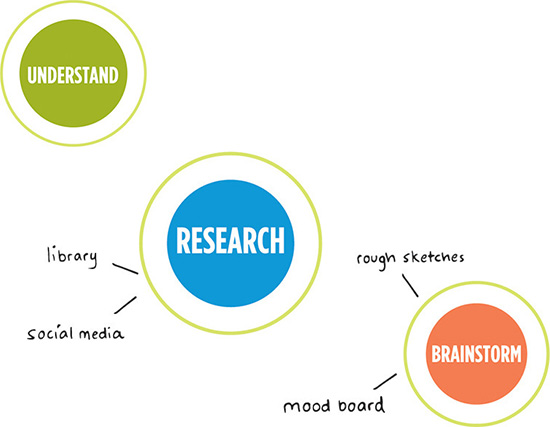
• Develop only one or two of your best ideas that effectively meet the objectives of the project.
• Select and design the touchpoints (i.e., logo, ad, or multiple channels) that are most appropriate for the target audiences and those that meet the needs of the project.
• Render tighter drawings on your computer, and prepare two to three prototype touchpoints for presentation.
• Ask for feedback, and refine and improve before you present.
• Quality-check every piece before your presentation.
Present
Sell your ideas.
• Rehearse your presentation, with your prototypes, to ensure that you are well-organized and prepared. The ideas you include in your presentation should be substantiated and supported by research-based data.
• Modify what doesn’t work, and rehearse again.
• Present your designs, ask for feedback, and be open to your audience’s (professors, mentors, design colleagues) reactions and suggestions.
• When your project idea is approved, go back to the design phase and rework or refine your presented ideas and develop additional touchpoints for the program as needed.
Produce
Execute final touchpoints.
• Generate final layouts for all of your touchpoints.
• Gather and produce the content (i.e., copy, high-res visuals, graphic elements).
• Prepare and distribute printing and coding specs for pricing (if it’s a professional project).
• Pre-flight check all of your files to confirm they were saved in the correct format (i.e., PDF, EPS, JPG), file size (300 dpi versus 72 dpi), and color profiles (CMYK versus RGB).
Assess
Evaluate and finalize your solution.
• Meet with the project team (this is your professor for a class project) and discuss the merits of each project.
• Evaluate the objectives outlined in the creative brief and make sure the project is on point and that you have satisfied the requirements listed.
• If metrics that measure the success of the program are available, include them in your assessment (percentage increase of website traffic, social media chatter, incoming calls, and so on).
• Use the best practices you discovered in this project in the creation of future projects.
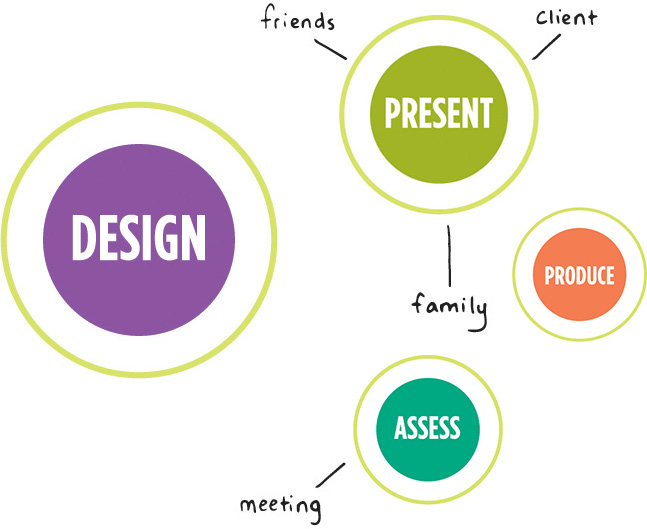
JUBENAL TORRES: juvytorres.com





